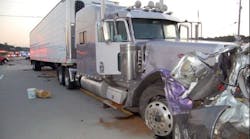In NTSB top transport issues, technology's pace quickening, human error in sharp relief
All indications in the National Transportation Safety Board's latest "Most Wanted List" of problems to fix in transportation point to one thing: in many ways, technology across that broad industry isn't just advancing, it's accelerating. It is both problem and solution.
Technology is the unifying and strongest theme running through NTSB's updated list this year as well as the related recommendations the agency has for state governments and others to solve these "most critical" woes in transportation. NTSB investigates transportation accidents and deaths throughout the year, and the Most Wanted List shows how the focus for those efforts is changing, as these problems themselves are.
Human-caused errors and limitations such as those caused by fatigue and distraction are costing lives, but technology and machines could help. Or driver/ operator assistance and oversight systems in transportation such as advanced and increasingly autonomous safety systems are surging ahead fast in terms of technology's potential and maturity.
"These issue areas are ripe for action now; if addressed, they would make a significant impact," the agency stated in outlining the list. There are some adjustments each year, but just flip back to the 2016 Most Wanted List for a telling look at what's been changing—as well as how fleets and trucking operations can expect efforts like safety inspection and law enforcement activity will be directed.
2016: Disconnect from deadly distractions.
2019: Eliminate distraction.
NTSB has sharpened this one up, getting away from "deadly distractions" to now fully any distraction behind the wheel. Naturally, there's a technology focus: the agency has called on the states to ban nonemergency use of mobile electronic devices that don't support the driving task and mobile device manufacturers to build in safeguards to disable use by drivers in moving vehicles.
NTSB also wants passenger bus/ motorcoach operators to issue policies prohibiting nonemergency cell phone use when driving.
2016: End substance impairment in transportation.
2019: End alcohol and other drug impairment.
NTSB correctly focuses the discussion to a single category here: drug-related impairment, and that includes alcohol. On that front, the agency has urged states to adopt stricter blood alcohol limits of 0.05% for motorists to be driving under the influence, but the agency is also clearly acknowledging changes that have been taking place in this arena such as cannabis legalization and growing prescription medication abuse.
"Impairment in transportation is not limited to just alcohol; it also includes impairment by other drugs—legal or illicit," NTSB stated. "We want a national drug testing standard for passenger vehicles and stronger screening and toxicology testing in commercial transportation."
2016: Reduce fatigue-related accidents.
2019: Reduce fatigue-related accidents (no change).
[RELATED]
2016: Require medical fitness for duty.
2019: Require medical fitness—screen for and treat Obstructive Sleep Apnea.
Note that a call to "reduce fatigue-related accidents" has survived from 2016 and remains on the Most Wanted List on its own, and NTSB has a number of related recommendations. Much more tied to fatigue now, however, is a related push for motor carriers to address Obstructive Sleep Apnea in drivers. NTSB has also asked the Federal Motor Carrier Safety Administration to encourage motor carriers to adopt fatigue-management programs.
In the Most Wanted List this year, the agency was very direct concerning Obstructive Sleep Apnea, stating: "We want to see mandatory screening and treatment for obstructive sleep apnea for rail and highway personnel in safety-sensitive positions."
2016: Promote availability of collision-avoidance technology in highway vehicles.
2019: Increase implementation of collision avoidance systems in all new highway vehicles.
[RELATED]
2016: Promote the completion of rail safety initiatives.
2019: Fully implement positive train control.
Here's where technology presents its shiniest silver bullet to target human error. Back in 2016, NTSB was calling for more availability of collision-mitigation and -avoidance systems, but there's no ambiguity left here now. The objective—for road vehicles as well as trains, since "positive train control" works similarly—is simply to get these systems out there across the board.
That is, collision-avoidance systems have transitioned from promising new technology to a moot point/ bygone conclusion. NTSB's wording approaches a sense of dismay these systems aren't already in uniform use. "Vehicle manufacturers should make this technology standard equipment on all vehicles," NTSB stated, "and consumers, informed about the technology's capabilities and limitations, should buy vehicles equipped with it."
2016: N/A - No list item targeting speeding.
2019: Implement a comprehensive strategy to reduce speed-related collisions.
In the last three years, speeding—amid more road congestion and languishing infrastructure—has earned its own place on the list. No matter the vehicle, speeding makes it likelier you'll crash and makes injuries worse if you do. And along with public awareness campaigns, NTSB calls for technology in various forms to help bring change.
That might include external systems such as automated enforcement tech and smart infrastructure that can detect and cite drivers for speeding or internal, in-vehicle systems of some kind. Regarding that latter kind, two words: speed limiters. NTSB has called for those devices on new heavy trucks and buses.
2016: N/A - No list item targeting hazardous materials transport.
2019: Ensure the safe shipment of hazardous materials.
This particular Most Wanted List item is more driven by economic realities than the others. Within the last three years in the transition from the Obama to the Trump Administration, for example, the United States has significantly expanded oil production, including from natural gas, and is now a net exporter. That also means more oil and refined fuels need to be transported, including with more tanker trucks on the roads.
Combining with other factors like infrastructure problems, Americans favoring larger vehicles, increasing roadway congestion, and growing transportation/ distribution needs, and all that flammable material out on the road could be life-threatening indeed.
2016: Strengthen occupant protection.
2019: Strengthen occupant protection (no change).
NTSB targets the motoring public most with this list item, but improving vehicle occupant protection and ensuring seatbelt use touches commercial trucks frequently and persistently as well—including in regards to passenger use, which can be a problem in heavy trucks.
NTSB has also called for lap-and-shoulder belts for all passengers in new buses and also would like to see tanker truck side-impact crashworthiness "to prevent catastrophic tank ruptures and limit post-collision fuel spillage."
That rounds out NTSB's latest Most Wanted List as it applies to trucking and ground transportation, but there's a final item: "Improve the safety of Part 135 aircraft flight operations." In 2016, that appeared as "Prevent loss of control in flight and general aviation." Part 135 aircraft offer things like air tours, medical evac, and charter flights and don't have to meet the same safety requirements as commercial airlines, which the agency said leaves them open to disaster.
In another three years, will drones, perhaps including those used in delivery innovations, have proliferated enough in use to catch NTSB's attention? If so, you can bet the answer will be to advance technology and enforcement—just as the agency's recommendations to address those less-formalized Part 135 aircraft requirements now.
"Let me point out something: the NTSB does not simply come up with these recommendations based on a whim," emphasized Chairman Robert Sumwalt. "It's a data-driven approach based on the results of our investigations and the tragic, senseless deaths that we investigate.
"The NTSB's Most Wanted List," he added, "is written in blood."






